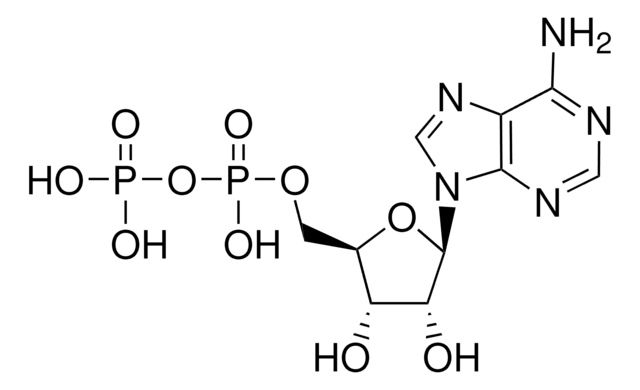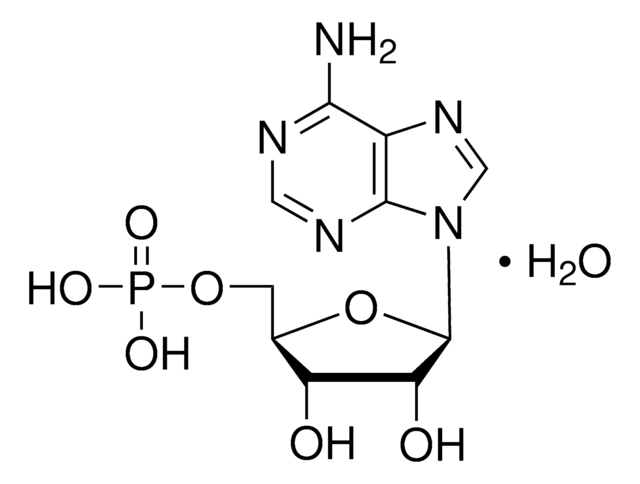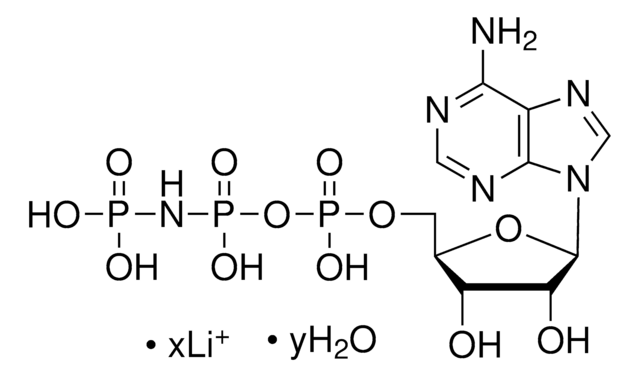Key Documents
A4386
Adenosine 5′-diphosphate bis(cyclohexylammonium) salt
≥95% (HPLC), crystalline, bacterial
Synonim(y):
A2P5P, ADP
About This Item
Polecane produkty
pochodzenie biologiczne
bacterial
Poziom jakości
Próba
≥95% (HPLC)
Postać
crystalline
rozpuszczalność
H2O: soluble, clear to slightly hazy, colorless to faintly yellow
temp. przechowywania
−20°C
ciąg SMILES
NC1CCCCC1.NC2CCCCC2.Nc3ncnc4n(cnc34)[C@@H]5O[C@H](COP(O)(=O)OP(O)(O)=O)[C@@H](O)[C@H]5O
InChI
1S/C10H15N5O10P2.2C6H13N/c11-8-5-9(13-2-12-8)15(3-14-5)10-7(17)6(16)4(24-10)1-23-27(21,22)25-26(18,19)20;2*7-6-4-2-1-3-5-6/h2-4,6-7,10,16-17H,1H2,(H,21,22)(H2,11,12,13)(H2,18,19,20);2*6H,1-5,7H2/t4-,6-,7-,10-;;/m1../s1
Klucz InChI
SCOUEIPNDLFPCX-IDIVVRGQSA-N
Szukasz podobnych produktów? Odwiedź Przewodnik dotyczący porównywania produktów
Zastosowanie
Przestroga
Kod klasy składowania
11 - Combustible Solids
Klasa zagrożenia wodnego (WGK)
WGK 3
Temperatura zapłonu (°F)
Not applicable
Temperatura zapłonu (°C)
Not applicable
Środki ochrony indywidualnej
Eyeshields, Gloves, type N95 (US)
Certyfikaty analizy (CoA)
Poszukaj Certyfikaty analizy (CoA), wpisując numer partii/serii produktów. Numery serii i partii można znaleźć na etykiecie produktu po słowach „seria” lub „partia”.
Masz już ten produkt?
Dokumenty związane z niedawno zakupionymi produktami zostały zamieszczone w Bibliotece dokumentów.
Klienci oglądali również te produkty
Nasz zespół naukowców ma doświadczenie we wszystkich obszarach badań, w tym w naukach przyrodniczych, materiałoznawstwie, syntezie chemicznej, chromatografii, analityce i wielu innych dziedzinach.
Skontaktuj się z zespołem ds. pomocy technicznej







![Adenosine 5′-[γ-thio]triphosphate tetralithium salt ≥75% (HPLC), powder](/deepweb/assets/sigmaaldrich/product/structures/319/398/e29221c2-3649-455b-bd33-583bb017ec7d/640/e29221c2-3649-455b-bd33-583bb017ec7d.png)